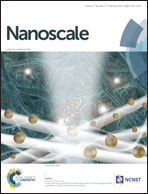Carbon nanodots as ligand exchange probes in Au@C-dot nanobeacons for fluorescent turn-on detection of biothiols†
Abstract
Au nanoparticle–carbon dot core–shell (Au@C-dot) nanocomposite was synthesized in aqueous medium at room temperature using the carbon dots as reducing agents themselves. The carbon nanodots also function as an effective stabilizer by forming a thin layer surrounding Au nanoparticles (Au NPs) similar to self-assembled monolayers. Ligand exchange with thiol containing biomolecules resulted in the release of carbon dots from the Au NP surface leading to an enhancement of fluorescence. Simultaneously the agglomeration of Au NPs stimulated by the interaction of biothiols led to changes in the surface plasmon properties of Au NPs. A detailed spectroscopic investigation revealed a combination of static and dynamic quenching being involved in the process. Thus, the Au nanoparticle–carbon dot composite could be used as a dual colorimetric and fluorometric sensor for biothiols ranging from amino acids, peptides, proteins, enzymes etc. with a detection limit of 50 nM.


 Please wait while we load your content...
Please wait while we load your content...